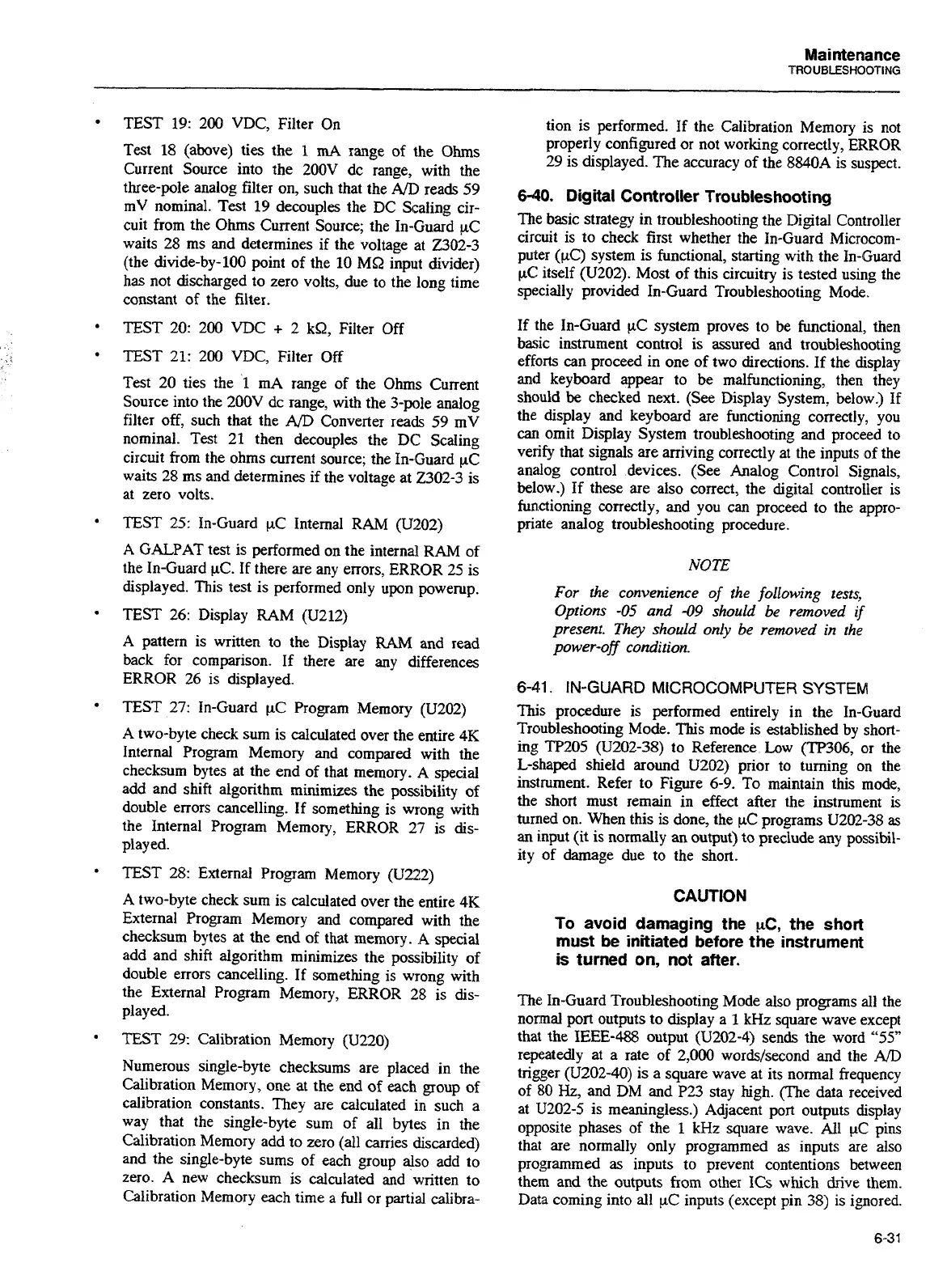Maintenance
TROUBLESHOOTING
--
-
TEST 19: 200 VDC, Filter On
Test
18
(above) ties the
1
mA
range of the Ohms
Current Source into the 200V dc range, with the
three-pole analog filter on, such that the
A/D
reads 59
mV nominal. Test 19 decouples the DC Scaling cir-
cuit from the Ohms Current Source; the In-Guard
yC
waits 28 ms and determines if the voltage at 2302-3
(the divide-by-100 point of the 10 MS2 input divider)
has not discharged to zero volts, due to the long time
constant of the filter.
TEST 20: 200
VDC
+
2 kS, Filter Off
TEST 21: 200 VDC, Filter
Off
Test 20 ties the
1
mA range of the Ohms Current
Sou~ce into the 200V dc range, with the 3-pale analog
filter off, such that the
A/D
Converter reads 59 mV
nominal. Test 21 then decouples the DC Scaling
circuit from the ohms current source; the In-Guard pC
waits 28 ms and determines if the voltage at 2302-3 is
at zero volts.
TEST 25: In-Guard
yC Internal RAM (U202)
A
GALPAT
test is performed on the internal RAM of
the In-Guard pC. If there are any errors, ERROR 25 is
displayed. This test is performed only upon powerup.
TEST 26: Display RAM (U212)
A
pattern is written to the Display RAM and read
back for comparison. If there are any differences
ERROR 26 is displayed.
TEST 27: In-Guard
yC Program Memory (U202)
A
two-byte check sum is calculated over the entire
4K
Internal Program Memory and compared with the
checksum bytes at the end of that memory.
A
special
add and shift algorithm minimizes the possibiiity of
double errors cancelling. If something is wrong with
the Internal Program Memory, ERROR
27 is dis-
played.
TEST 28: External Program Memory
(U222)
A
two-byte check sum is calculated over the entire
4K
External Program Memory and compared with the
checksum bytes at the end of that memory.
A
special
add and shift algorithm minimizes the possibility of
double errors cancelling. If something is wrong with
the External Program Memory, ERROR 28 is dis-
played.
TEST
29: Calibration Memory (U220)
Numerous single-byte checksums are placed in the
Calibration Memory, one at the end
of
each group of
calibration constants. They are calculated in such a
way that the single-byte sum of all bytes in the
Calibration Memory add to zero (all carries discarded)
and the single-byte sums of each group also add to
zero. A new checksum is calculated and written to
Calibration Memory each time
a
full or partial calibra-
tion is performed. If the Calibration Memory is not
properly configured or not working correctly, ERROR
29 is displayed. The accuracy of the 8840A is suspect.
6-40.
Digital
Controller Troubleshooting
The basic strategy in troubleshooting the Digital Controller
circuit is to check first whether the In-Guard Microcom-
puter
(PC) system is functional, starting with the In-Guard
pC
itself (U202). Most of this circuitry is tested using the
specially provided In-Guard Troubleshooting Mode.
If the In-Guard yC system proves to be functional, then
basic instrument control is assured and troubleshooting
efforts
can
proceed in one of two directions. If the display
and
keyboard appear to be malfunctioning, then they
should
be
checked next. (See Display System, below.) If
the display and keyboard are functioning correctly, you
can
omit Display System troubleshooting and proceed to
verify that signals are arriving correctly at the inputs
of
the
analog control devices. (See Analog Control Signals,
below.)
If
these are also correct, the digital controller is
functioning correctly, and you can proceed to the appro-
priate analog troubleshooting procedure.
NOTE
For the convenience of the following tests,
Options
-05
and
-09
should be removed
if
present.
They
should only be removed
in
the
power-off condition.
6-41.
IN-GUARD
MICROCOMPUTER SYSTEM
This procedure is performed entirely in the In-Guard
Troubleshooting Mode. This mode is established by short-
ing
TP205 (U202-38) to Reference Low (TP306, or the
L-shaped shield around U202) prior to turning on the
instrument. Refer to Figure 6-9. To maintain this mode,
the short must remain in effect after the instrument is
turned on. When this is done, the
pC
programs U202-38
as
an input (it is normally an output) to preclude any possibil-
ity of damage due to the short.
CAUTION
To avoid damaging the
G,
the short
must
be
initiated before the instrument
is
turned on, not after.
The In-Guard Troubleshooting Mode also programs all the
nonmal port outputs to display a
1
kHz
square wave except
that the IEEE-488 output (U202-4) sends the word "55"
repeatedly at a rate of 2,000 words/second and the
AD
trigger (U202-40) is a square wave at its normal frequency
of
80
Hz,
and DM and P23 stay high. (The data received
at U202-5 is meaningless.) Adjacent port outputs display
opposite phases of the
1
kHz
square wave.
Ail
$
pins
that are normally only programmed
as
inputs are also
programmed as inputs to prevent contentions between
them and the outputs from other
ICs
which
drive them.
Data coming into all yC inputs (except pin 38) is ignored.
Artisan Technology Group - Quality Instrumentation ... Guaranteed | (888) 88-SOURCE | www.artisantg.com

